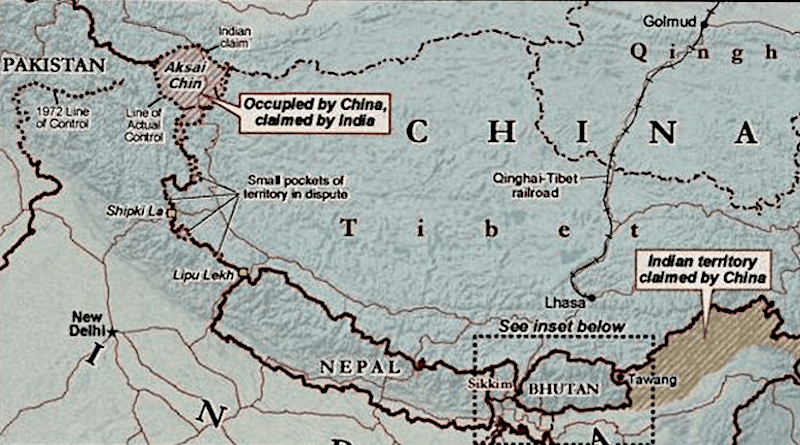China-India: Closer To The Edge – Analysis
By Observer Research Foundation
By Manoj Joshi
The past year has witnessed a spate of reports about Chinese ‘model villages’ coming up in disputed areas of its Himalayan border with India and Bhutan. In January 2021, NDTV had reported a Chinese village had come up on the banks of the Tsari Chu river in the Longju region, the site of the first Sino-Indian clashes in 1959. A passing reference to the earlier construction in the US Department of Defense’s annual China military power report added more grist to the mill even as the news channel came up with yet another report of a second model village, 93 km east of the one reported earlier.
The latest report has been denied by the Indian Army which told the channel that the location ‘corresponding to the coordinated mentioned in your query lies to the north of the LAC.’ Earlier, the Chief of Defence Staff, Gen Bipin Rawat, too, had said while there had been construction, ‘these so-called villages are well within their (Chinese) side of the LAC.’ The MEA, however, said China had been undertaking construction activities in the border areas, ‘including those that it has illegally occupied over the decades’ and that India had not accepted ‘such illegal occupation’.
This confusion can be cleared by cutting through the web of officialese. The NDTV report says that the second enclave lies 6 km within India between the LAC and the international boundary. Actually, there is no ‘international boundary’ between India and China. Such boundaries are always delineated and then demarcated through the joint agreement between the two countries involved. What we have, and the Army and Rawat are correct on the score, is a Line of Actual Control (LAC).
But these technicalities only serve to obfuscate the wider issue here, which is of populating the rugged Himalayan frontier on both sides. Within days of the end of the 19th Communist Party of China (CPC) Congress on October 24, 2017, Xinhua reported about a letter written by two sisters of a Tibetan herder family to chairman Xi, detailing their experiences in the border areas. Xi promptly replied, praising the girls and thanking them for their loyalty and the contribution they were making in safeguarding China’s territory.
This was a signal, as clear as could be, that the Chinese had become concerned over the situation on their southern border with India and that those concerns were being taken up at the very apex level. For the Chinese, the wake-up call came from the Indian intervention in Doklam to prevent them from building a road to the Zompelri (Jampheri) ridge in what India recognised as Bhutanese territory. The confrontation had lasted several months, and then both sides agreed to pull back. No sooner it had happened than the Chinese went on an infrastructure construction spree, not just in northern Doklam, but along the entire LAC. This featured an upgradation of their military facilities and a new strategy of populating the frontier area.
This was through a scheme of constructing Xiaokang (moderately prosperous) villages, aimed at serving two functions — to upgrade the physical quality of life of the border citizens, and to ensure border security. According to Jayadeva Ranade, president of the Centre for China Analysis and Strategy, the plans call for the building of more than 600 such villages along the LAC over the next few years.
The stoppage of India-Tibet border trade following the 1962 border war led to the abandonment of scores of frontier villages dependent on trade. In the ensuing years, the problem of depopulation of villages in the Himalayan region became worse. Land in the mountain region is meagre and making a living tough. It began with the migration of able-bodied men and was followed in a generation by their families who found life much easier in the plains. In 2017, a report said in Uttarakhand itself, some 3,000 villages had gone ‘ghost’, with houses locked up and abandoned. This is likely to be the pattern in other parts of the Himalayas as well.
But the problem of depopulation is only one of the two drivers of this Chinese drive for border village construction. The other is politics. By pushing into unpopulated areas of the Himalayan region, Beijing is not only trying to establish the basis for their possession, but also taking care of border security.
For this reason, there is need to think systematically about how the government can support habitation in the frontier areas. Building roads, tunnels and military facilities is important, but it is not enough. What people need is livelihood and a life. There are options that can be explored — growing Himalayan medicinal herbs as well as encouraging wool production, carpet weaving and trade in the villages adjacent to the border. Some of these may have to, as in the old days, be made semi-nomadic, with provision for relocating to lower areas in the harsh winter months. Perhaps the biggest drawback, and this affects the entire Himalayan zone, is the lack of medical infrastructure even in towns like Nainital or Shimla, leave alone the frontier regions.
To counter this requires systematic planning and specialised administration, perhaps the revival of a frontier administrative service may not be a bad idea. But most important, this is something that needs money. It is time that the Government of India, too, realises that merely building up military capacity in the forward areas is not enough. Fellow columnist Devinder Sharma once mooted the idea that this expenditure be seen as an ecological tax for the value the Himalayas provide for the country’s larger ecosystem.
This article originally appeared in The Tribune.The views expressed above belong to the author(s).

